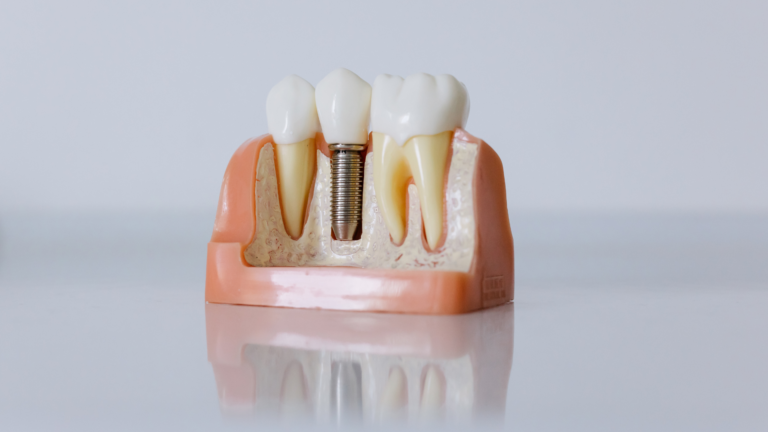What Do Dental Implants Look Like?

Understanding Dental Implants
Components of a Dental Implant
A dental implant is a sophisticated device designed to replace missing teeth and is composed of three main parts. The implant post is the section that is surgically inserted into the jawbone, acting as a root for the artificial tooth. This post is typically made of titanium, a material well-known for its durability and biocompatibility.
The second component is the abutment, which serves as a connector between the implant post and the replacement tooth. It is securely attached to the post once the jawbone has healed.
Lastly, the crown represents the visible part of the dental implant. It is custom-made to match the color, shape, and size of the patient’s natural teeth, providing a seamless aesthetic appearance.
The success of a dental implant relies heavily on the precise interaction between these components, ensuring stability and functionality akin to natural teeth.
Types of Dental Implants
Dental implants come in various types to accommodate different dental conditions and patient preferences. Endosteal implants are the most common type, typically shaped like small screws and placed directly into the jawbone. Another type is the subperiosteal implant, which rests on top of the jawbone under the gum tissue, often used when the jawbone isn’t sufficient to support endosteal implants.
- Endosteal Implants: Most common, placed in the jawbone
- Subperiosteal Implants: Sit on top of the jawbone, under the gums
- Zygomatic Implants: Least common, anchored in the cheekbone
The choice between these implants depends on the patient’s bone density, gum health, and specific dental needs. Each type offers a unique approach to restoring functionality and aesthetics.
Mini dental implants, a smaller version of endosteal implants, are also available. They are often used for stabilizing lower dentures and in situations where traditional implants are not viable. The selection process for the right type of implant is critical and should be made with the guidance of a dental professional.
The Anatomy of an Implant
The anatomy of a dental implant is designed to mimic the structure of a natural tooth. At its core, an implant consists of three main parts: the implant post, the abutment, and the crown. The implant post acts as the tooth root, anchoring the entire structure to the jawbone. Above this, the abutment serves as a connector between the post and the crown, which is the visible part that resembles a natural tooth.
- Implant Post: Typically made of titanium, integrates with the bone.
- Abutment: Connects the post to the crown, often made of the same material.
- Crown: Custom-made to match the surrounding teeth, usually ceramic.
The precise engineering behind each component ensures that dental implants in Manhattan Beach not only look natural but also function effectively. The success of an implant lies in the seamless integration of these parts, creating a durable and aesthetically pleasing replacement for missing teeth.
The Aesthetic Appearance of Dental Implants
Color and Material Choices
When selecting dental implants, patients have a variety of color and material options to ensure a natural-looking result. The goal is to match the implant to the surrounding teeth in terms of shade and translucency. Dental implants are typically made from titanium or zirconia, materials known for their strength and biocompatibility.
- Titanium: This metal is the most common choice for implants due to its durability and the body’s ability to accept it. Titanium implants are often coated with a ceramic material to improve their aesthetic appearance.
- Zirconia: An alternative to titanium, zirconia implants are white and can more easily blend with the natural color of teeth. They are a single piece, which eliminates the need for a separate abutment.
The selection of the implant material and color is crucial for the overall aesthetic outcome and patient satisfaction. It’s important to consider the longevity and performance of the material as well as its appearance.
Shape and Size Considerations
When it comes to dental implants, shape and size are critical for both function and aesthetics. The goal is to mimic the natural tooth as closely as possible, which requires precise customization.
- The width of the implant is chosen based on the available bone structure and the space requirements of the adjacent teeth.
- The length is determined by the depth of the jawbone, ensuring stability without affecting sensitive areas such as nerves or sinuses.
- The shape, whether cylindrical or tapered, is selected to match the natural root structure and to facilitate osseointegration.
The right combination of shape and size is essential for the implant to withstand the forces of biting and chewing while looking indistinguishable from natural teeth.
It’s important to note that these considerations are not just for individual teeth. For patients requiring multiple implants, the overall harmony and balance within the mouth must be maintained. This ensures that the implants do not look out of place and that the bite is correctly aligned.
Gum Integration and Visual Harmony
The success of dental implants is not only measured by their functionality but also by their aesthetic integration with the surrounding gum tissue. Proper gum integration is crucial for a natural appearance, ensuring that the implant does not stand out against the rest of the teeth.
- The contour of the implant should mimic natural gum lines.
- Color matching is essential to avoid visible discrepancies.
- The emergence profile must be carefully crafted to support the gums.
Attention to detail in the design and placement of the implant can significantly affect the visual harmony between the implant and the natural teeth. This harmony is vital for patient satisfaction and confidence.
Ensuring that the implant is indistinguishable from natural teeth requires meticulous planning and execution. The final outcome should be a seamless blend with the patient’s smile, contributing to both the function and aesthetics of the dental restoration.
The Procedure of Installing Dental Implants
Initial Consultation and Planning
The journey to restoring your smile with dental implants begins with a thorough initial consultation and planning phase. During this stage, your dental professional will assess your oral health and discuss your aesthetic and functional needs. A detailed treatment plan is then crafted, tailored to your specific situation.
- Review of medical and dental history
- Comprehensive oral examination
- Discussion of treatment options and expectations
- Imaging studies (e.g., X-rays, CT scans)
This phase is crucial as it lays the groundwork for a successful implant procedure, ensuring that the implants will be placed in the optimal position for both function and appearance.
The planning process may also involve the creation of a mock-up or a 3D model of your mouth, which helps in visualizing the end result. It’s important to address any questions or concerns at this stage to ensure you are fully informed and comfortable with the proposed treatment plan.
Surgical Procedure Steps
The surgical procedure for installing dental implants is a critical phase that requires precision and expertise. The process typically involves several key steps, each crucial for the success of the implant.
- Preparation of the implant site: The dentist or oral surgeon makes an incision in the gum to expose the bone.
- Drilling the bone: A specialized drill creates space in the jawbone for the implant.
- Placing the implant: The titanium implant is carefully inserted into the bone.
- Closing the gum: The incision is sutured to allow for healing.
The goal of the surgical procedure is to place the implant securely within the jawbone, ensuring it can support a dental prosthesis effectively.
It’s important to note that the complexity of the procedure can vary depending on individual cases and the type of implant being used. Patients are typically under local anesthesia, and sedation options may be available for those who need it. Post-operative care is essential to monitor healing and prevent infection.
Healing and Osseointegration Process
Following the surgical placement of dental implants, patients enter a critical healing phase. Osseointegration is the process where the implant post integrates with the jawbone, creating a stable foundation for the replacement tooth. This period can vary in length, typically taking several months to ensure a strong bond.
During this time, it’s essential to follow post-operative care instructions to promote successful healing. Some key points include:
- Avoiding strenuous activity that could disrupt the implant site
- Maintaining good oral hygiene to prevent infection
- Adhering to a soft food diet to minimize pressure on the implant
The success of dental implants heavily relies on the osseointegration process. It’s a time for the body to naturally fuse the implant with the bone, ensuring the longevity and functionality of the prosthetic tooth.
Patients should expect to have follow-up visits with their dentist to monitor the progress of osseointegration and to make any necessary adjustments to their care regimen. It’s a journey that requires patience and diligence, but the end result is a durable and reliable dental restoration.
Comparing Dental Implants to Natural Teeth
Visual Similarities
Dental implants are meticulously crafted to mimic the look of natural teeth, ensuring a seamless blend with the patient’s existing dentition. The color, shape, and overall appearance are tailored to create an indistinguishable match from the surrounding teeth, providing a natural-looking smile.
- Color Matching: Dental implants are designed to match the shade of the patient’s natural teeth, ensuring a consistent and natural appearance.
- Contour and Texture: The surface of the implant crown is contoured and textured to reflect light similarly to natural enamel.
- Alignment and Positioning: Implants are positioned to align with the natural arch of the patient’s teeth, maintaining the original bite and smile aesthetics.
The goal of dental implants is not only to restore function but also to achieve a visual harmony that enhances the patient’s confidence and quality of life.
Functional Differences
While dental implants are designed to mimic the look and feel of natural teeth, there are some functional differences to consider. Dental implants do not have the same sensory feedback as natural teeth, which means that the sensation when biting or chewing can be different.
- Natural teeth are embedded in the jawbone through periodontal ligaments, allowing for slight movement and sensitivity to pressure and temperature.
- Dental implants are anchored directly into the jawbone, which provides stability but lacks the proprioceptive feedback of natural teeth.
The absence of periodontal ligaments in dental implants means that they do not have the natural shock absorption that real teeth do. This can affect how one chews and perceives texture.
It’s important to note that despite these differences, dental implants are highly functional and can restore nearly all the capabilities of natural teeth, including biting, chewing, and speaking. They are a durable and long-lasting solution for tooth loss.
Longevity and Durability
Dental implants are renowned for their durability and longevity. Unlike natural teeth, which may decay or suffer from various dental diseases, implants are made from materials that resist corrosion and wear. However, the lifespan of a dental implant can be influenced by several factors, including the patient’s oral hygiene, lifestyle, and the quality of the initial surgical procedure.
The success rate of dental implants is high, often lasting for decades with proper care. This makes them a cost-effective, long-term solution for tooth replacement.
Here is a comparison of longevity between dental implants and natural teeth:
Dental Implants
- Over 90% success rate after 10 years
- Less susceptible to decay
- Not affected by common dental diseases
Natural Teeth
- Can last a lifetime with proper care
- Prone to cavities and decay
- Susceptible to gum disease
It’s important to note that while dental implants are not subject to decay like natural teeth, they can still be compromised by gum disease. Regular dental check-ups and proper oral hygiene are essential to maintain the implant and surrounding tissues in good health.
Maintenance and Care for Dental Implants
Daily Cleaning and Oral Hygiene
Maintaining the longevity and aesthetic appeal of dental implants is largely dependent on proper daily cleaning and oral hygiene. Regular brushing and flossing are essential, as they prevent plaque buildup and protect against potential gum disease, which can compromise implant stability.
- Brush at least twice a day with a soft-bristle toothbrush.
- Use a non-abrasive toothpaste to avoid scratching the implant surface.
- Floss daily with unwaxed tape or implant-specific floss to remove debris between implants.
- Consider using an interdental brush to clean hard-to-reach areas around the implant.
It is crucial to follow a consistent oral hygiene routine to ensure the health and functionality of dental implants. Neglecting this can lead to complications that may affect not only the implant but also the surrounding natural teeth.
Regular dental check-ups are also vital, as they allow professionals to monitor the condition of the implants and address any issues promptly. Remember, while dental implants are designed to be durable, they require the same level of care as natural teeth to remain in top condition.
Regular Dental Check-Ups
Ensuring the longevity and optimal function of dental implants involves regular dental check-ups. These visits allow for the timely identification and management of any issues, potentially extending the life of the implant. A dentist in Manhattan Beach, CA, or your local area, will typically recommend a check-up schedule tailored to your specific needs.
- Examination of implant integrity
- Cleaning around the implants
- Assessment of gum health
- Review of oral hygiene practices
Regular check-ups are crucial for maintaining dental implant health and preventing complications. During these visits, your dentist can provide personalized advice and care to keep your implants in top condition.
Addressing Complications and Repairs
Even with diligent care, dental implants can face complications such as infections, implant loosening, or damage to surrounding tissues. Addressing these issues promptly is crucial to the longevity of the implant.
- Regular monitoring can detect problems early.
- Minor issues may be resolved with non-invasive treatments.
- More serious complications might require surgical intervention.
It is essential to maintain open communication with your dental professional to ensure any signs of complications are addressed before they escalate.
Follow-up appointments play a pivotal role in the maintenance of dental implants. During these visits, dentists can assess the health of the implant, the surrounding gums, and the bone structure. If repairs are necessary, they can range from simple adjustments to replacement of the implant components.
Frequently Asked Questions
What are the main components of a dental implant?
A dental implant typically consists of three main components: the implant post that is surgically placed into the jawbone, the abutment that connects the implant post to the replacement tooth, and the crown or prosthetic tooth that is visible above the gum line and resembles a natural tooth.
How do dental implants differ from natural teeth in appearance?
Dental implants are designed to closely mimic the appearance of natural teeth, with similar color, shape, and size. However, they may be distinguishable upon close inspection or by a dental professional due to the materials used and subtle differences in light reflection.
Can dental implants be matched to the color of my natural teeth?
Yes, dental implants can be customized in color to match your natural teeth. The dental crown that attaches to the implant can be crafted from materials like porcelain or ceramic, which can be tinted to blend seamlessly with the surrounding teeth.
What should I expect during the dental implant procedure?
The dental implant procedure typically involves an initial consultation and planning, followed by the surgical placement of the implant post into the jawbone. After a healing period that allows for osseointegration, an abutment and crown are attached to complete the process.
How long do dental implants last compared to natural teeth?
Dental implants are designed to be a long-term solution and can last for many years with proper care. While they do not decay like natural teeth, the surrounding gum and bone must be maintained to support the implant. With good oral hygiene and regular check-ups, implants can last as long as natural teeth, if not longer.
What kind of maintenance do dental implants require?
Dental implants require similar maintenance to natural teeth, including daily brushing and flossing to prevent plaque buildup and gum disease. Additionally, regular dental check-ups are important to monitor the implant and address any complications or repairs that may be needed.






